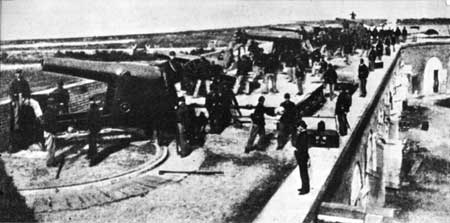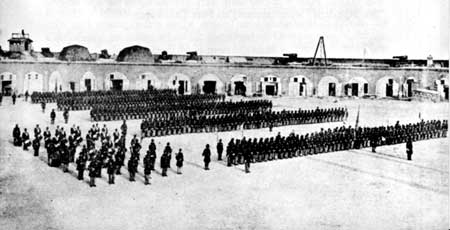|
FORT PULASKI National Monument |
 |

Third Rhode Island Artillery at Fort Pulaski.
From The
Photographic History of the Civil War.
"The immortal Six Hundred"
Late in October 1864, Fort Pulaski became involved in one of the most barbaric episodes of the Civil War when more than 500 prisoners of war—Confederate officers of rank from lieutenant to lieutenant colonel—were brought to Cockspur from a stockade on Morris Island in Charleston Harbor. These officers, captured in battle and representing every Southern State and the border States of Missouri, Maryland, and Kentucky, were the victims of a cruel policy of retaliation and are known in Southern history as "The Immortal Six Hundred."
The dismal story began at Charleston when Confederate Gen. Samuel Jones, in an attempt to lift the bombardment of that city, adopted a dangerous stratagem of using prisoners of war as a shield. On June 13, 1864, Jones notified Union Gen. J. G. Foster, Commandant of the Department of the South, that 5 generals and 45 field officers of the U. S. Army had been quartered in a part of the city which for many months had been exposed night and day to the fire of Federal guns. Foster immediately retaliated by requesting that 55 Confederate Officers of equal rank be sent from the prison at Fort Delaware to be placed in a stockade on Morris Island under the guns of Fort Sumter.
This ugly situation was ended by a general exchange of the officers on August 3, but on that day Jones placed 600 more Federal officers in the residential section of Charleston, which was under bombardment. Federal reaction was prompt. Six hundred additional Confederate officers were sent down from Fort Delaware and this time they were placed in the stockade on Morris Island under the guns of Fort Sumter.
What benefit Jones really expected to derive from his strategy is certainly not clear. There is evidence that he soon regretted the game he was playing and made every effort possible to have the Federal officers moved out of Charleston, but, due to the fortunes of war, Jones was powerless to stop the chain of events he had started. He could not get rid of his unwelcome guests, and, as General Sherman, poised for his march through Georgia, threatened the security of the Confederate prison at Andersonville, Ga., hundreds of new Federal prisoners sent from that place began to arrive in Charleston every day.

Review of the 48th New York Volunteers on Fort Pulaski parade
ground.
From History of the 48th Regiment New York
Volunteers in the War for the Union, 1861—1865.
In October, Fate intervened. Yellow fever, which had been smoldering in Charleston for many weeks, became epidemic, and the acute danger from this source gave Jones the excuse to remove the prisoners without authority from his superiors. He sent the officers to Columbia and the men to Florence. On learning of this move, Foster ordered the Confederate prisoners from Morris Island to Fort Pulaski.
When the "Immortal Six Hundred" arrived at Cockspur Island, they presented a forlorn picture. Uniforms in tatters, barefooted, suffering from diarrhea and hacking coughs, their ranks had already been reduced to 520. Forty-nine were in hospitals, 4 had escaped, 2 had been exchanged, and 2 had taken the oath of allegiance. Six were in a convict prison on Hilton Head Island for attempted escape, 13 were unaccounted for, and 4 were buried in the sands of Morris Island.
At Fort Pulaski, Col. Philip P. Brown, Jr., commandant of the post, greeted the prisoners and promised to make the fort the model military prison of the United States. He said that he had already requisitioned blankets and clothing, full army rations, and plenty of fuel.
Colonel Brown, 157th New York Volunteers, was a completely humane man and won the respect of his Confederate prisoners, but he could not carry out the promises he had made. His requisitions were ignored. In consequence, he could issue neither blankets nor clothing. Out of his garrison supplies he fed the prisoners as well as he could, but fuel on Cockspur was scarce and fires in the cookstoves could be lighted but once a day. When the weather turned cold there was neither wood nor coal to heat the prison casemates. Because of his attitude of humanity, Brown drew upon himself the censure of his commanding general.
On December 15, Brown was ordered to impose a starvation ration composed of one-quarter pound of bread, 10 ounces of cornmeal, and one-half pint of pickles daily, and 1 ounce of salt every 5 days. Under this new order prisoners were permitted to secure additional food from sutlers, but since they had no money and were not allowed to receive funds from the Confederate States, they could purchase no food.
For 43 days in the coldest months of an unusually severe winter, the prisoners at Pulaski subsisted on this cornmeal and pickle diet. Cats and dogs that strayed through the prison bars were immediately cooked and eaten. But day by day the men grew weaker. At night, with no blankets and no warming fires, they had to keep moving about or freeze. By mid-January 1865, scurvy began to take its toll.
Meanwhile, Savannah had surrendered to General Sherman, and as a result the Federal forces in the far South were entirely reorganized. On January 21, Fort Pulaski became a part of the District of Savannah under the command of Bvt. Maj. Gen. Cuvier Grover, U. S. Volunteers, and, on January 27, following an inspection by Grover's medical director, Pulaski's prisoners were put back on full rations. This timely action saved the lives of many of the men. On March 5 the long ordeal was ended. Four hundred and sixty-five survivors of the original "Six Hundred" were returned to Fort Delaware.

|

|
|
Last Modified: Mon, Mar 4 2002 10:00:00 pm PDT |


